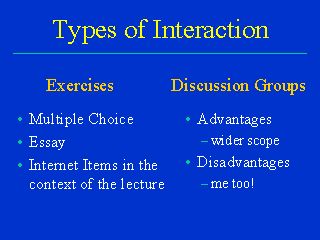Each of the noted forms of interaction have their advantages and disadvantages. Lecture-based exercises address a one-to-one interaction between the teacher and student. They may take various forms. I have experimented with multiple choice exercises, e
ssay question exercises, and questions the require a student to obtain information from another site on the Internet (e.g. a paper in MMWR) and answer questions on it in the context of the lecture. My preference is for the latter, because it allows the f
aculty member to assess how the student is applying the key concepts from the lecture. Examples of web-based assignments can be viewed at http://www.pitt.edu/~epi2670/assign.htm.
Discussion groups provide a different type of interaction. It brings the dynamics of group interaction into play. Listservers allow all of the students to see and read the questions and responses between faculty and students. In this sense, it can appr
oximate the classroom setting. There are some imminent disadvantages of discussion groups, though. Most notably, there will be a pattern of one to two students providing early responses to the teacher’s questions, following by several “me-too” responses
from the other students. This gets to be burdensome to read after the fourth or fifth “me-too” note.









